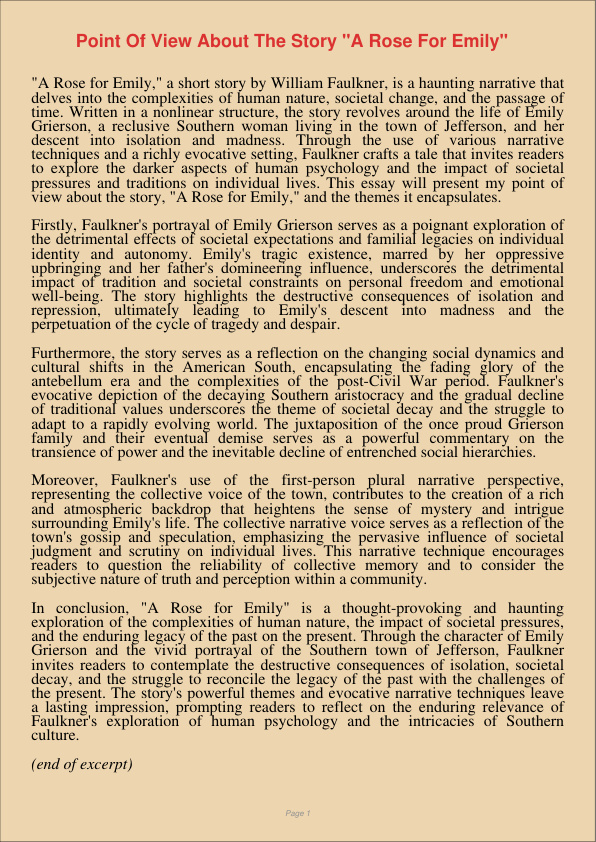Point Of View About The Story A Rose For Emily
Dec 31, 2023
story
emily
Macro & Microeconomics
Family & Consumer Science

“A Rose for Emily,” a short story by William Faulkner, is a haunting narrative that delves into the complexities of human nature, societal change, and the passage of time. Written in a nonlinear structure, the story revolves around the life of Emily Grierson, a reclusive Southern woman living in the town of Jefferson, and her descent into isolation and madness. Through the use of various narrative techniques and a richly evocative setting, Faulkner crafts a tale that invites readers to explore the darker aspects of human psychology and the impact of societal pressures and traditions on individual lives. This essay will present my point of view about the story, “A Rose for Emily,” and the themes it encapsulates.
Firstly, Faulkner’s portrayal of Emily Grierson serves as a poignant exploration of the detrimental effects of societal expectations and familial legacies on individual identity and autonomy. Emily’s tragic existence, marred by her oppressive upbringing and her father’s domineering influence, underscores the detrimental impact of tradition and societal constraints on personal freedom and emotional well-being. The story highlights the destructive consequences of isolation and repression, ultimately leading to Emily’s descent into madness and the perpetuation of the cycle of tragedy and despair.
Furthermore, the story serves as a reflection on the changing social dynamics and cultural shifts in the American South, encapsulating the fading glory of the antebellum era and the complexities of the post-Civil War period. Faulkner’s evocative depiction of the decaying Southern aristocracy and the gradual decline of traditional values underscores the theme of societal decay and the struggle to adapt to a rapidly evolving world. The juxtaposition of the once proud Grierson family and their eventual demise serves as a powerful commentary on the transience of power and the inevitable decline of entrenched social hierarchies.
Moreover, Faulkner’s use of the first-person plural narrative perspective, representing the collective voice of the town, contributes to the creation of a rich and atmospheric backdrop that heightens the sense of mystery and intrigue surrounding Emily’s life. The collective narrative voice serves as a reflection of the town’s gossip and speculation, emphasizing the pervasive influence of societal judgment and scrutiny on individual lives. This narrative technique encourages readers to question the reliability of collective memory and to consider the subjective nature of truth and perception within a community.
In conclusion, “A Rose for Emily” is a thought-provoking and haunting exploration of the complexities of human nature, the impact of societal pressures, and the enduring legacy of the past on the present. Through the character of Emily Grierson and the vivid portrayal of the Southern town of Jefferson, Faulkner invites readers to contemplate the destructive consequences of isolation, societal decay, and the struggle to reconcile the legacy of the past with the challenges of the present. The story’s powerful themes and evocative narrative techniques leave a lasting impression, prompting readers to reflect on the enduring relevance of Faulkner’s exploration of human psychology and the intricacies of Southern culture.